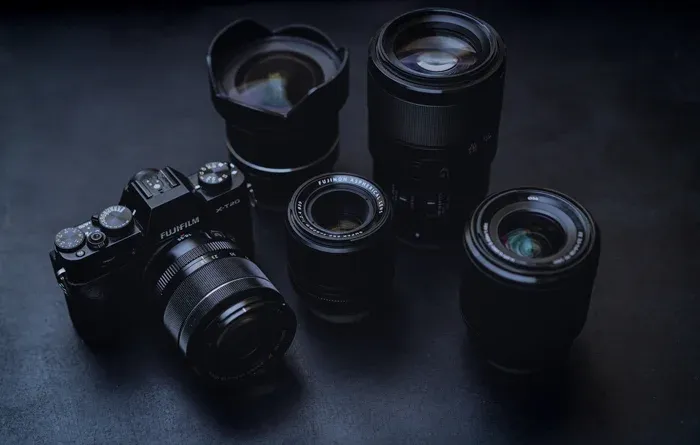Mastering Your Shot: A Comprehensive Guide to Selecting the Perfect Camera Lens

Photography is a beautiful art that requires a lot of patience, skill, and equipment. One of the most important tools in a photographer's arsenal is their camera lens. The lens you choose can greatly impact the outcome of your photos, so it's important to choose the right one for your needs.
In this guide, we'll cover everything you need to know about choosing the right camera lens.
- Understand Your Camera System+
Before you start looking for a new lens, it's important to understand the camera system you're working with. Different camera brands have different lens mounts, so it's essential to choose a lens that's compatible with your camera body. For example, if you have a Canon camera, you'll need a lens with an EF or EF-S mount.
2. Determine Your Needs
The next step is to determine your photography needs. Are you a landscape photographer, or a portrait photographer, or do you shoot in low-light conditions? These factors will determine the type of lens you need. For example, if you're a landscape photographer, you'll want a wide-angle lens with a focal length between 10-24mm. If you shoot portraits, you'll need a lens with a focal length of 50-85mm.
3. Consider the Focal Length
The focal length is the distance between the lens and the camera sensor when the lens is focused at infinity. It's measured in millimeters (mm) and determines the angle of view and magnification of the lens. A lens with a shorter focal length will have a wider angle of view and a smaller magnification, while a lens with a longer focal length will have a narrower angle of view and a larger magnification.
4. Aperture
The aperture is the opening in the lens that allows light to enter the camera. It's measured in f-stops and determines how much light the lens can capture. A lens with a wide aperture (small f-stop number) will allow more light to enter the camera, making it ideal for low-light photography. It also creates a shallow depth of field, which is great for portraits. On the other hand, a lens with a narrow aperture (large f-stop number) is better for landscape photography because it creates a deeper depth of field, keeping everything in focus.
5. Image Stabilization
Image stabilization is a feature that helps reduce camera shake, which can lead to blurry photos. If you shoot in low light conditions or with a telephoto lens, image stabilization can be a game-changer. It allows you to shoot at slower shutter speeds without worrying about camera shake, resulting in sharper photos.
6. Lens Quality
Finally, it's important to consider the quality of the lens you're buying. A high-quality lens will produce sharper, clearer photos with less distortion and chromatic aberration. However, higher-quality lenses often come with a higher price tag. It's up to you to determine your budget and decide what level of quality you're willing to pay for.
Conclusion,
Choosing the right camera lens can greatly impact the outcome of your photos. It's important to understand your camera system, determine your needs, consider the focal length and aperture, and factor in image stabilization and lens quality. With these factors in mind, you'll be able to choose the perfect lens for your photography style and take your skills to the next level.
FAQs
A camera lens is a transparent optical element that focuses light onto a camera's sensor or film. The lens is responsible for the image quality of a photograph, and there are many different types of lenses available, each with its own unique characteristics.

2. What are the different types of camera lenses?
There are two main types of camera lenses: prime lenses and zoom lenses. Prime lenses have a fixed focal length, while zoom lenses can be zoomed in and out to change the focal length.
3. What is focal length?
Focal length is the distance between the lens and the camera's sensor or film when the lens is focused on infinity. The focal length of a lens determines the field of view (FoV) of the camera. A wide-angle lens has a short focal length and a large FoV, while a telephoto lens has a long focal length and a narrow FoV.
4. What is aperture?
Aperture is the opening in the lens that allows light to pass through. The aperture is measured in f-stops, and a lower f-stop number means a wider aperture. A wider aperture allows more light to pass through the lens, which can be useful for low-light photography. However, a wider aperture also results in a shallower depth of field, which means that only a small part of the image will be in focus.
5. What is shutter speed?
Shutter speed is the amount of time that the camera's shutter is open. The shutter speed is measured in seconds or fractions of a second. A faster shutter speed lets in less light, while a slower shutter speed lets in more light. A fast shutter speed is useful for freezing motion, while a slow shutter speed can be used to create blur effects.
6. What is ISO?
ISO is the sensitivity of the camera's sensor to light. A higher ISO number means that the sensor is more sensitive to light, which can be useful for low-light photography. However, a higher ISO number also results in more noise in the image.
7. What are the factors to consider when choosing a camera lens?
The factors to consider when choosing a camera lens include the type of photography you want to do, the focal length you need, and the aperture and shutter speed you want to use.
8. How do I know which camera lens is right for me?
The best way to know which camera lens is right for you is to experiment with different lenses and see what works best for you. You can also ask other photographers for their recommendations.
9. How do I take care of my camera lens?
To take care of your camera lens, it is important to keep it clean and free of dust and fingerprints. You should also avoid dropping or banging your lens, and you should store it in a safe place when you are not using it.

10. Where can I buy camera lenses?
Camera lenses can be purchased from a variety of retailers, including camera stores, online retailers (Imaginext), and even some department stores.
I hope this helps!

